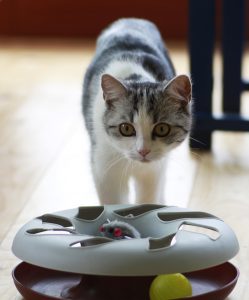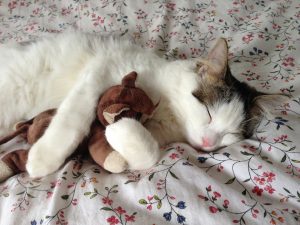Cats are just as interested in toys and play as much as dogs – even though your feline friend may not show it! Whereas you probably won’t see a cat tearing across a field to fetch a toy back to you, cats play and the toys they use are just as important. In this blog we look at the best types, and actually why cats should be encouraged to play.
Why cats need to play.
Think of a cat and a picture of them lounging on the most comfortable chair might spring to mind. Don’t let that fool you, they still need stimulation and to spend time playing. Their big cat cousins do the same, lying in the sun, seemingly watching the world go by, but like all cats they are still alert. Cats are wired for play – albeit a hunting play.
Some cats seem happy to play with any creature that moves – birds or mice etc. Although this often drives owners mad – finding presents in the kitchen, this hunting ins tinct cannot be removed from a cats mindset, it’s inbuilt. The behaviour can be helped by a suitable distraction though, and that’s where play comes in to simulate hunting.
tinct cannot be removed from a cats mindset, it’s inbuilt. The behaviour can be helped by a suitable distraction though, and that’s where play comes in to simulate hunting.
There are a number of cats that don’t display a hunting behaviour at all, they still have the instinct, but choose not to use it. They should also be encouraged to play, although if they are very laid-back, it might be more difficult to instigate.
The main reasons that cats need play are:
- To keep them mentally stimulated – especially for indoor cats.
- To help them exercise – equally important for overweight cats and again indoor cats.
What are suitable cat toys?
Cats like to chase and pounce, just as they would do in the wild! There is a vast array of toys on the market to cater for this, however we have some preferred choices of our own. Kong, for example, have made toys for pets since 1976 and are one of the market leaders in keeping our pets stimulated. Many people may think Kong toys are for dogs only, but there is also a great cat range to choose from. Cats can have their own toy balls, chew toys, scratch toys and stimulating feeding toys – where treats are put inside the toy and the cat has to work how to get them out.
These are great for you cat to play with by themselves. Some toys will take more effort on the owners side as well, such as teaser toys. These items consist of a toy (often a bug with a feather attached) on a string, attached to a stick. The stick allows the owner to flick the toy bug around (and avoid scratched hands from quick cats), simulating a natural movement of prey. Cats will love to pounce and grab at these. The most important thing to remember with this type of toy is supervision and not leaving you cat with it alone, as the string can cause accidents.
 What about catnip?
What about catnip?
Catnip can be found in all sorts of toys and can drive some cats wild with excitement! It is the smell of it that some cats find irresistible. Catnip is a member of the mint family of plants and will generally stimulate 70 to 80% of cats – so if yours doesn’t seem to take any notice of a catnip toy, there’s nothing wrong!
Those who do like it often exhibit behaviour such as rubbing their heads on the toy, rolling around with it, even being vocal with it. This behaviour generally lasts around 10 minutes then the cat can get ‘immune’ to the smell for about 30 minutes.
What else can they use to play?
As well as chasing and pouncing, cats love to climb and play. No blog on cat toys could go without mentioning cat towers, where our feline friends love to sit, use inbuilt scratch posts and generally hide inside tunnels, if they have been added. Some cats in multi-cat households even use these to display hierarchical behaviour over their companions (and even dogs!)
Being up higher still goes back to the cat being able to see anything moving in the ‘territory’ – part of the hunt and play scenario. These towers come in different sizes and are definitely worth considering, especially if your cat uses furniture as a scratch post!

